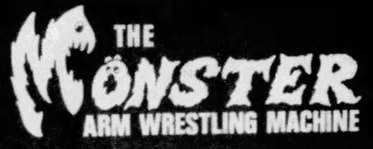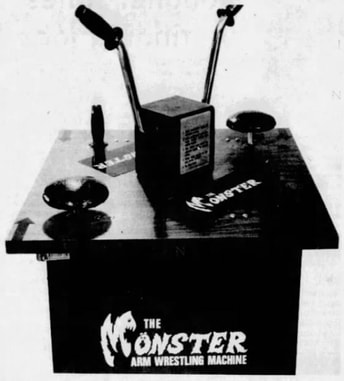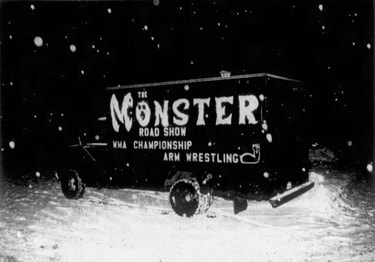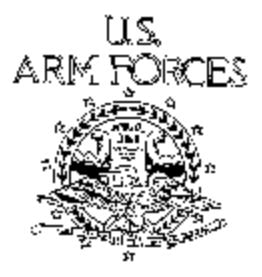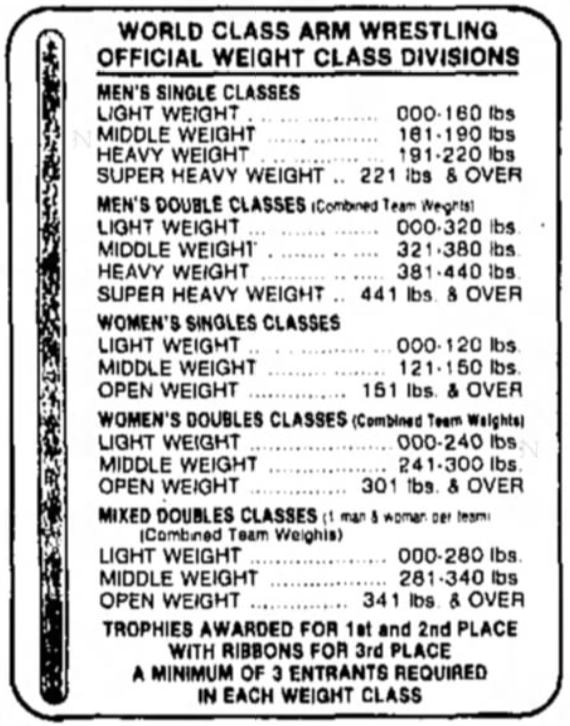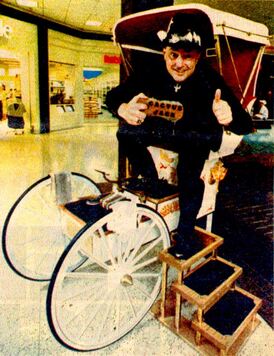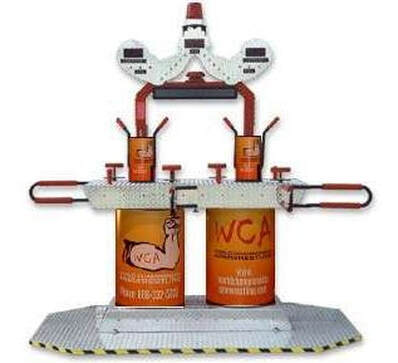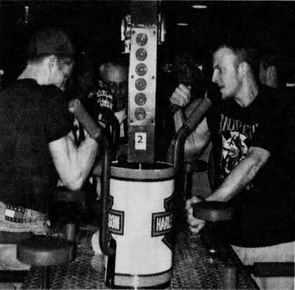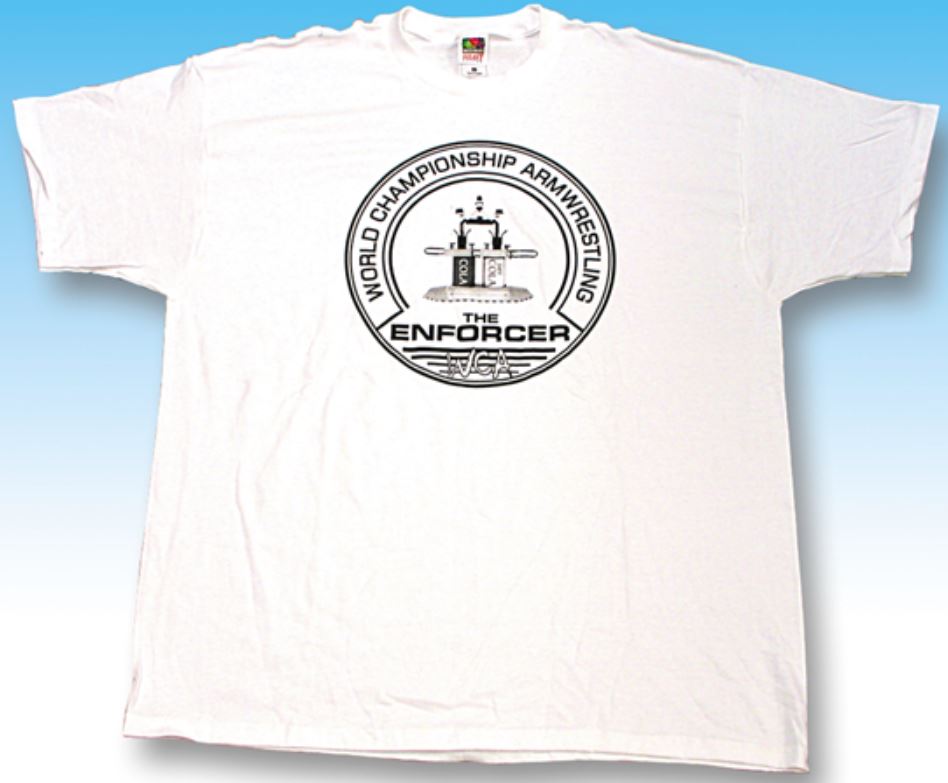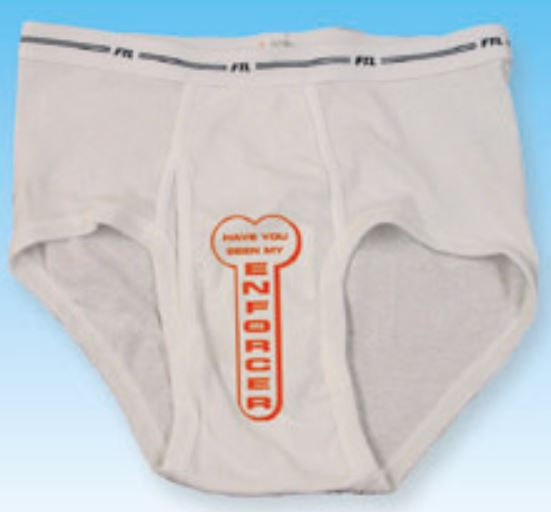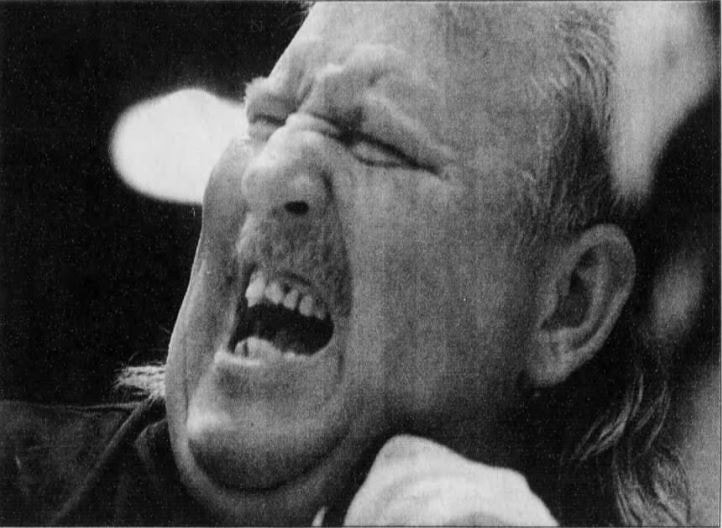The History of Monster Arm Wrestling
Atlantic, Iowa native Jack Barringer always knew he wanted to be rich. As a boy he sold garden seeds door to door and pretty much anything else he could to make money. Upon graduating high school, his goal was simple: to be successful. Unfortunately, he didn’t have a clue of how to make this happen. To educate himself, he turned to reading books by successful businessmen and started attending seminars put on by motivational speakers. This gave him both the confidence and a blueprint for achieving success.
During his twenties and early thirties Jack was involved in a number of businesses, from milk delivery to real estate, camera stores, and car rentals. But he soon realized that if he wanted to really make it big, he would need to invent something.
One evening in 1977 Jack was having a drink with his friend Jerry Ewing in a lounge in Hastings, Nebraska. There was a brass rail running the length of the bar which was a bit loose and Jerry kept idly twisting it. Jack became annoyed by the sound, so he grabbed the bar to stop Jerry from twisting it by applying force in the opposite direction. It was a battle of attrition. They then came up with the idea of placing a quarter on the rail with the objective of making it fall off towards your opponent. It proved to be a simple and fun test of wrist strength. Others in the bar witnessed Jack and Jerry playing this game and soon many patrons wanted to try. The rail twisting went on for a couple of hours.
Jack saw potential in marketing a simple game of strength that pitted two individuals against each other. When he got home, he put some handles on a pipe gadget and started showing it to people. Everyone liked it, but a few suggested that some sort of armwrestling machine would be better. This led him to start working on what would become The Monster.
Over the next few months, Jack kept making tweaks to the machine’s design – about 20 in all – before arriving at the model that went into production. The apparatus had handlebars sticking out of either side of a metal box atop a cabinet. Competitors sat on each side of the cabinet, placed their right elbow on an adjustable elbow pad, and grabbed the handle using any grip they wanted. Their non-competing hand grasped a fixed hand peg. The objective was to lower the handlebar to the table top, at which point a bell would sound and a light would go on.
The initial set of rules was printed on the machine:
- Each contestant must sit between arrows.
- Each contestant must remain seated during the entire match.
- The elbow pad must be adjusted before the contest starts.
- Elbow must remain on the pad during the contest.
- No time limit.
Jack promoted the Monster as an alternative to regular hand-to-hand armwrestling. He felt the machine was a better test of strength. While technique played a big role in armwrestling (and especially wristwrestling), it played a much smaller role on the Monster machine. Competitors hands never touch, so there is no messing around with the grip. Plus, the height of the elbow pads could be adjusted which helped to negate the leverage difference between competitors with different arm lengths.
The Monster was originally intended to be a coin-operated machine that would be sold to restaurants and bars. But this meant that it would be competing for floor space with other coin-operated machines (e.g. pinball machines, arcade games). Jack realized that changing his business strategy might be a better idea once he saw how people reacted to it. The first time he brought the machine to a local bar to test it out in early 1978, he decided to hold a tournament. Approximately 50 people took part, and they went crazy for it! Right then, Jack saw that there was potential to make more money travelling and hosting Monster tournaments in different bars.
He came up with the following business model. Bars would pay him approximately $300 to run a Monster tournament, which he would guarantee would last at least four hours (he would spread matches out if needed). Participants would also pay a $5 entry fee, which would be used to pay for the trophies. He could also work with beer sponsors to cover the prize costs.
Jack travelled throughout central Iowa in 1978. He moved from town to town, hosting several tournaments per week. Many of these towns only had populations of about 1,000, but this was seen as an advantage. The towns didn’t host many events, but when they did, people came out in droves. Farm boys came out to test their strength on the Monster, and their family and friends came out to cheer them on.
One day, a couple of guys from northern Iowa came down for a tournament and asked Jack if he’d be willing to drive up to their area to run some events. But Jack was simply too busy. So they asked him if they could rent the machine. A deal was soon struck. For a few thousand dollars, Jack with give them a Monster machine and exclusive rights to run tournaments in three counties in northern Iowa. He would also teach them how to book and run the tournaments. Plus, Jack would also receive a $50 sanctioning fee for every tournament that was held. When Jack saw that they signed the agreement without batting an eye, and that it was just for three out of 99 counties in the state, he new that franchising was the way of the future for Monster Corp.
Jack quickly formed the World Monster Association and started to promote Monster franchising opportunities. He advertised in newspapers and tried to increase public exposure to the new sport. His biggest opportunity to date to showcase the machine came when he staged a Monster tournament at the Iowa State Fair on August 19th, 1978. To drum up publicity he called on two-time World Wristwrestling Champion and Iowa native Steve Lusby to make an appearance. The tournament was a big success and the Fair was very pleased with the new addition.
Monster Corp.’s efforts, combined with positive word-of-mouth advertising, resulted in many potential investors contacting them to inquire about purchasing rights to certain territories. Some were interested in just a county or two, while others wanted rights to entire states. The franchise fees were negotiated on a case-by-case basis. While initial growth was in the Midwest, by the summer of 1980, contests were being held in 24 states, and there were upwards of 125 contests being held each month!
Over the next couple of years, the Monster network continued to expand to more states, then to Canada and eventually overseas to places like the United Kingdom and Australia. The Australian investors wanted to purchase excusive rights for the whole country, and even flew Jack over for a month to help them get started!
Mr. Barringer was very aware of the danger of over-saturating the market with machines, which is why he did not allow individual establishments to purchase them. Only licensed franchisees could host events, and they were warned not to return to the same places more than a few times a year. A Monster armwrestling tournament had to be seen as a special event – one not to miss. If tournaments were held in the same location on a monthly basis, they would likely loose some of their special appeal. He liked to give the marketing of the mechanical bull as an example of an approach that should be avoided. After a mechanical bull was featured in the 1980 hit movie Urban Cowboy starring John Travolta, it saw a huge boost in popularity, with bars across the country buying them and hosting contests. But it didn’t take long for patrons to lose interest: it was a case of too much all at once.
Monster Arm Wrestling was presented as a sport, rather than a novelty, which was key to its success. There were local, regional, and state championships. Tournament winners won awards (generally trophies) and could work towards becoming a member of the Monster Mafia, an exclusive club for competitors who had won at least five tournaments or earned at least eight top-two finishes. Entry into the Monster Mafia entitled you to wear a Monster Mafia t-shirt and a certificate indicating your induction into the World Monster Association Hall of Fame.
In 1981, it was felt that the success of the new sport warranted an official National Championship. With Ames, Iowa, being the central hub for Monster – Jack lived there and it was where Monster Corp. was based – it was selected to be the host city for the inaugural Monster Arm Wrestling National Championship. The tournament was held on Valentine’s Day and was hosted by Steve Lusby (by this time he was a three-time World Wristwrestling Champion). It was said to have attracted upwards of 200 competitors and while Iowans won the most classes, national titles also went to pullers from Nebraska, South Dakota, Minnesota, and Wyoming.
In Monster’s early years, the base rules underwent a few changes. The most significant difference from the initial ruleset was the adoption of a standard match time limit of three minutes. Ideally, the match would end with a pin, but if this didn’t occur within the allotted time, the victory would go to the competitor who demonstrated more control during the match. A few different methods for determining this were tested, before eventually settling on a “three one-minute rounds” format. In each round, the competitor who manages to hold the handlebar on the winning side of the table for at least 31 of 60 seconds is awarded a point. The match doesn’t stop. So if there isn’t a pin within the first two minutes, the result will either be 1-1, in which case control during the third minute with determine the winner, or the result will be 2-0, in which case the competitor who is down can only win the match by getting a pin during the third minute. This formula would prove to be very popular with spectators. It is important to note that while fouls are issued during the match (e.g. for not remaining seated, body contact, etc.), the match keeps going until a competitor gets three fouls. The only exception is when a pin occurs because of a foul (in which case the match is restarted from the point just before the foul occurred). Interestingly, letting go of the handlebar during the match results in an automatic loss, so competitors need to be careful with the grip they take.
By the middle of the 1980’s, Monster Arm Wrestling tournaments had spread to almost every state, with approximately 300 machines in circulation. The annual National Championships which started in Ames, became bigger each year, prompting a move to Des Moines in 1983 and to Palatine, Illinois (a Chicago suburb) in 1984. The World Monster Association had become the biggest armwrestling organization in the world, by event count. Monster Arm Wrestling had made Jack a millionaire, but he was getting burnt out. He was tired of all the travelling and late nights, and he was itching to start working on something new, so around late 1984 he stepped back from the business.
Jack spent the next two years working on a couple of new machines. One was named Uncle Tug, an indoor tug-of-war machine. This machine’s success was short-lived. The main problem was that tug-of-war is a team event, and it was difficult to get several full teams together on a single evening for a contest.
Jack’s other idea was for a new and improved armwrestling machine. There would be three main differences between the new machine and the Monster. First, it would require competitors to stand, rather than to be seated. (This matched the trend that was occurring in regular hand-to-hand armwrestling.) Second, the machine would allow competitors to wrestle with different arms (e.g. a right arm versus a left arm), which would eliminate the excuse of a competitor having to compete with their “bad” arm. Third, the machine could accommodate teams of two, be it two men against two men, two women against two women, or mixed pairs.
In early 1987, around the time Over the Top was released in theatres, Jack unveiled his new creation: the World Class Arm Wrestling machine (also known as the Real McCoy). He spent the first few months of the year traveling to franchise trade shows, in an attempt to build up a network similar to what he had done with Monster. For an investment of $15,000 to $25,000, licensees could acquire a machine, a protected territory in which to run tournaments, and a three-day seminar to learn how to promote tournaments and work with sponsors.
Over the course of the year, the World Class Arm Wrestling network had built up to about 25-30 franchisees. There was enough momentum to warrant a National Championship, which was held at the Showboat Hotel and Casino in Las Vegas on February 26-27, 1988. Unfortunately, it would be the only one ever held. The problem? An inordinate amount of arm breaks. While broken arms were an occasional occurrence with the Monster machine (as in regular hand-to-hand armwrestling tournaments), they occurred more frequently with the World Class Arm Wrestling machine. The angle of the handlebars seemed to be the culprit, forcing competitors’ arms into movements that were less natural. Reports of broken arms came in faster than the machines could be recalled, and ultimately several lawsuits were filed. It forced World Class Events Corp. into bankruptcy less than two years after the machine had been introduced.
The end of World Class Arm Wrestling led Jack to drop out of the armwrestling business. However, Monster Arm Wrestling was still alive. While the number of tournaments being held nationwide was down significantly from the heydays of the early 1980s, the sport was still going strong in Iowa and some of the surrounding states. One of the leading promoters was Lee Ann Krough of Atkins, Iowa.
At 5’10” and over 200 lbs, Lee Ann was quite strong. Growing up on a dairy farm, she built up her strength by lugging around 6-gallon milk containers. Here first foray into organized armwrestling happened in 1978 when she entered a regular armwrestling tournament in Cedar Rapids. She didn’t win, but she had a pretty good excuse: her opponent was Mildred Choplick, the reigning world wristwrestling champion.
The next contest in which she competed was a Monster tournament in the spring of 1980. She experienced immediate success and started to travel to different events in the area. But she couldn’t find enough tournaments: she wanted more. So she and her husband Tom bought into Monster Arm Wrestling and started hosting tournaments in eastern Iowa.
Lee Ann experienced great success in the sport through the early 1980s, winning five national titles and several state titles. She and Tom travelled and hosted more and more tournaments, and they eventually bought out all the other franchisees in the state. Having helped run the Monster tournament at the Iowa State Fair beginning in 1980, by the middle of the decade the Kroughs were overseeing the entire event. Only five National Monster Arm Wrestling Championships were held, after which the Iowa State Fair tournament became the most prestigious annual event in the sport.
Monster tournaments continued to be held in fewer and fewer locations across the U.S. throughout the 1990s, with one key exception: in Iowa. After the Kroughs split in 1989, Tom got out of the Monster business, leaving Lee Ann to make all the decisions. She became so associated with the sport that she adopted the moniker “Mother Monster”, which she was originally called by a couple of competitors who kept forgetting her name.
While Jack was no longer in the armwrestling business, he was by no means retired. He developed a new marketing persona – a smooth-talking cowboy named Cactus Jack – and got into the shoeshine business. His idea was to turn a conventional shoeshine into an experience, using designer shoeshine stands. For example, one stand was designed as a horse-drawn buggy, another was a king’s throne, and yet another was an airplane cabin with real plane seats offering first-class and coach shines. But his biggest success came in the mid-1990s with One Shot, a solid all-purpose cleaner about the size and shape of a bullet. He would sell several million dollars’ worth of it on QVC during this period.
After a nearly 15-year absence, Cactus Jack was back in the armwrestling business by the end of 2002. This time the company was called World Championship Armwrestling and the machine was called The Enforcer. Inspired by the growth of professional wrestling and the explosion in popularity of reality TV, his new idea was to push the characters who took part in the sport.
The Enforcer was much like the World Class Arm Wrestling machine – competitors competed standing up, and they could compete in teams with either arm. The machine could be customized to display sponsor logos.
The biggest obstacle to the growth of World Championship Armwrestling was the cost of the machine. While the original Monster machines cost $750 to manufacture, the Enforcer cost $15,000 and had to be sold for significantly more than this. It was simply too expensive to interest investors. No more than a handful of machines were made. Nevertheless, World Championship Armwrestling tournaments were held through to about 2009 in Iowa, and there was accompanying merchandise as well as “The enFORCEmen” – a Hall of Fame for competitors who won at least five events.
While the World Class Arm Wrestling and Enforcer machines are no longer around, the Monster is still alive and well in Iowa. Lee Ann continues to travel and host dozens of tournaments each year, with the help and support of her family. Over the years, all four of her kids have been involved in the business in some way or another, as have been her mother, most of her siblings, many of her nieces and nephews, and even some of her grandchildren. Whether it be to officiate matches, run brackets, handle registrations, maintain the machines, Monster is definitely a family affair.
Mother Monster and her team have made many small improvements to the machine over the years to address various issues. These included changing the elbow pad material (for better comfort), replacing the plastic bicycle grips with rubber ones (the plastic ones occasionally slipped doff the end of the handlebar), and adding a wooden frame next to each side of the cabinet to contain the chairs (so that they wouldn’t slip around during the match).
Lee Ann maintains an up to date schedule of upcoming Monster tournaments in Iowa on her website, which also includes results from the National Championships and the Iowa State Fair events.
Monster Arm Wrestling has been a staple attraction at the Iowa State Fair since 1978 and it’s there to stay for the foreseeable future. It is THE tournament to win for bragging rights in the sport. If you’re ever in Des Moines in August, check it out: it’s the best way to get a sense of what Monster Arm Wrestling is all about!
Researched and Written by Eric Roussin
Published on July 31, 2019.
Special thanks to Jack Barringer and Lee Ann Krough for granting interviews for this article.
Monster Arm Wrestling Introductory video from the 2017 Iowa State Fair
